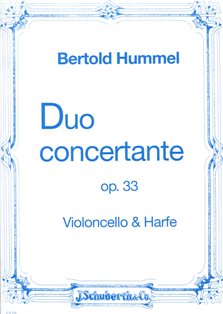Duo concertante for Violoncello and Harp op. 33 (1968)

I. Fantasia appassionata
II.
Burlesque ![]() beginning
beginning
First Perfomance: June 27, 1968, München, Prinz Carl-Palais
Klaus Storck / Helga Storck

Duration: 14 Minutes
Publisher: Schott Music ED 20283 / ISMN: M-001-14978-5
| I. | II. |
Video: Works by Hummel on youtube
Formed
in two movements - Fantasia appassionata and Burlesque
- the work gives both instrumentalists opportunity to demonstrate virtuosity.
At the beginning of the 1st movement a motto is presented by
the harp and reappears often in the course of the movement. Metamorphoses on a
march-like rhythm are interrupted by solo cadenzas by both players. A reprise-like
final melody leads to a close in extreme pp.
The whirring motion of the Burlesque
is characterised by variable metre. Rhapsodic passages divide the form into 7
easily identifiable sections.
The work was written in during 1967/68 as a
commission for the Bayerische Akademie der Schönen Künste (Bavarian
Academy of the Fine Arts) in Munich and was performed for the first time at their
annual general meeting in the1968 by the Storck - Duo.
Bertold Hummel
Bertold Hummel (on the 15th December, 1985 in Bayerischer Rundfunk (Bavarian Radio):
Having been
asked to make some comments regarding my opus 33, may I start by pointing to the
title "Duo concertante", which indicates that the piece is conceived
as a gesture for the virtuoso performer.
A particularity of the piece is
the basic tuning of the harp in the series: B C D E-flat F-sharp G A, which
remains unchanged during the whole first movement. (Thus avoiding any unwanted
re-tuning noises.) All melodic and harmonic shapes in the harp part are taken
from this source. The violoncello, of course, exploits the opportunity to fill
in the rest of the chromatic scale.
A motto - played by the harp - opens
the movement - the arabesques in the violoncello provide contrast. A march-like
rhythm is hinted at and undergoes numerous variations. The basic material - extracted
from the scale of the harp - is constantly, even in transpositions, present in
the cello part. The two written-out cadenzas provide both instrumentalists with
the chance to display solo skills. The motto - as at the beginning - leads demonstratively
to the final melodic idea, which fades out in extreme pp. In this Fantasia appassionata,
one could speak of an extended variation form.
The 2nd movement - Burlesque
as title - works with variable metre, i.e. the lengths of the basic note-values
remain the same, the number of them varies from bar to bar. From this, fluctuating
rhythmical structures result. The procedure is not exactly new, we see it often
in Stravinsky. Boris Blacher systematised it, and to him we owe, as far as I know,
the term "variable Metrik" ("Variable metre"). Insertions,
as if in "speaking freely", subdivide the movement.
Despite the
12-tone outer appearance, tonal fields grow up out of pedal-points. (A procedure
that occurs relatively seldom in the 60s in our century - in more recent times
somewhat more frequently.)
The work was written in 1967 as a commission for
the Bayerische Akademie der Schönen Künste (Bavarian Academy of the
Fine Arts) in Munich and was performed for the first time at their annual general
meeting in the1968 by the Storck - Duo, to whom it is also dedicated.
Press
Badische Zeitung, September, 1972
A very welcome new discovery is the "Duo concertante" by Bertold Hummel from the year 1968, a testimony to the fact that the music of today can indeed open up new fields in the conversation between the two instruments - under the condition that, as in Hummel's case, it concerns itself thoroughly with them. This work also begins with a Fantasia, but "appassionata", full of temperament and bearing a powerful signature, followed by a Burlesque which lives completely from rhythm. Piquant details make the work pleasant for the ear, as e.g. when both instruments pay their respects to harmonics, an effect for which the harp is especially well equipped with its resources of glissandi, trills and tremoli or the inherent arpeggio technique.
Zeitung, Memmingen, 13th July, 1985
The expressive piece, in which cello or harp alternate in taking the leading part, exploits the full potential of each instrument and produces extremely dramatic effects.
Main-Post, 1st June, 1970
The "Duo concertante" by Bertold Hummel, dedicated to the Storck-Duo, is striking in its musical vitality in appassionata character, in the inventive virtuosity which Hummel grants to the instruments, in the rhythmical Fantasy and the undogmatic development of motifs. The Burlesque had to be repeated as an encore: the audience had enjoyed this lively work and was carried away by the captivating play of the Storck-Duo.